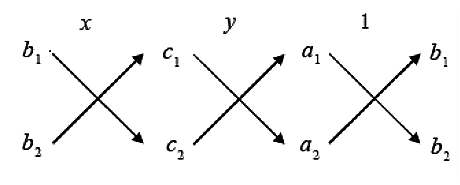SYSTEM OF SIMULTANEOUS LINEAR EQUATIONS WITH FRACTIONAL
Subscribe to our ▶️ YouTube channel 🔴 for the latest videos, updates, and tips.
To solve system of linear equations, we may use different methods :
Using elimination method :
- Write the given equations in standard form.
- Compare the coefficients of the variables that we are planning to eliminate.
- If the coefficients are same and they have opposite signs, by adding those two equations, we can eliminate the variable.
- If the coefficients are not same, multiply it by some constants and make it same.
Using substitution method :
To use this method, we have to take one of the equations and solve for one variable in terms of other variable.
Cross multiplication method :
The given equations should be in the form,
a1 x + b1y + c1 = 0
a2 x + b2y + c2 = 0

Solve the following pairs of simultaneous equations:
Problem 1 :
2x + 1/3y = 1
3x + 5y = 6
Solution:
2x + 1/3y = 1 ---> (1)
3x + 5y = 6 ---> (2)
Multiply the equation (1) by 3, we get
6x + y = 3 ---> (3)
Multiply the equation (2) by 2, we get
6x + 10y = 12 ---> (4)
Subtracting equation (3) & (4)
-9y = -9
y = 1
By applying y = 1 in equation (2)
3x + 5(1) = 6
3x + 5 = 6
3x = 1
x = 1/3
So, the solution is x = 1/3 and y = 1.
Problem 2 :
4x + 3y = 5
2x - 3/4y = 1
Solution :
4x + 3y = 5 ---> (1)
2x - 3/4y = 1 ---> (2)
Multiply the equation (2) by 4, we get
8x - 3y = 4 ---> (3)
Adding equation (1) & (3)
12x = 9
x = 3/4
By applying x = 3/4 in equation (1)
4(3/4) + 3y = 5
3 + 3y = 5
3y = 2
y = 2/3
So, the solution is x = 3/4 and y = 2/3.
Problem 3 :
1/3x + y = 10/3
2x + 1/4y = 11/4
Solution:
1/3x + y = 10/3 ---> (1)
2x + 1/4y = 11/4 ---> (2)
Multiply the equation (1) by 3, we get
x + 3y = 10 ---> (3)
Multiply the equation (2) by 4, we get
8x + y = 11 ---> (4)
(4) × 3 ==> 24x + 3y = 33 ---> (5)
Subtract equation (3) & (5)
-23x = -23
x = 1
By applying x = 1 in equation (1)
1/3(1) + y = 10/3
1/3 + y = 10/3
y = 9/3
y = 3
So, the solution is x = 1 and y = 3.
Problem 4 :
3x - 2y = 5/2
1/3x + 3y = -4/3
Solution:
3x - 2y = 5/2 ---> (1)
1/3x + 3y = -4/3 ---> (2)
Multiply the equation (2) by 3, we get
x + 9y = -4 ---> (3)
(3) × 3 ==> 3x + 27y = -12 ---> (4)
Subtracting equation (1) & (4)
-29y = 29/2
y = -1/2
By applying y = -1/2 in equation (1)
3x - 2(-1/2) = 5/2
3x + 1 = 5/2
3x = 3/2
x = 1/2
So, the solution is x = 1/2 and y = -1/2.
Problem 5 :
x = 1/3y
2y - 6x = 9
Solution:
x = 1/3y ---> (1)
2y - 6x = 9 ---> (2)
By applying x = 1/3y in equation (2)
2y - 6(1/3y) = 9
2y - 2y = 9
0 = 9
So, there is no solution.
Subscribe to our ▶️ YouTube channel 🔴 for the latest videos, updates, and tips.
Recent Articles
-
Finding Range of Values Inequality Problems
May 21, 24 08:51 PM
Finding Range of Values Inequality Problems -
Solving Two Step Inequality Word Problems
May 21, 24 08:51 AM
Solving Two Step Inequality Word Problems -
Exponential Function Context and Data Modeling
May 20, 24 10:45 PM
Exponential Function Context and Data Modeling